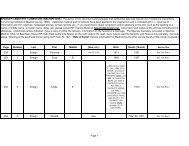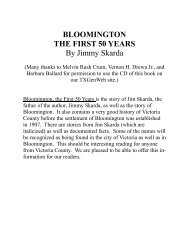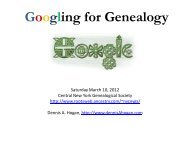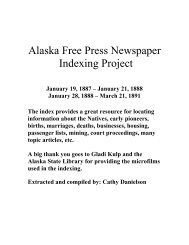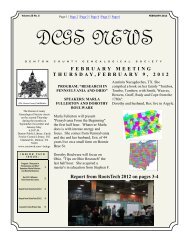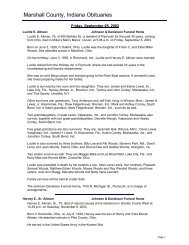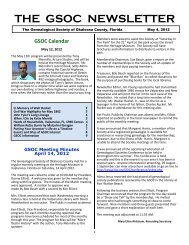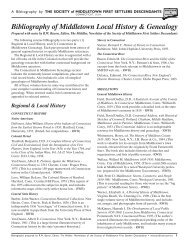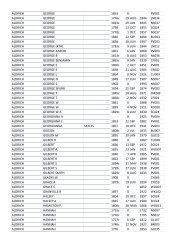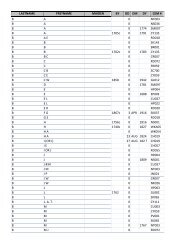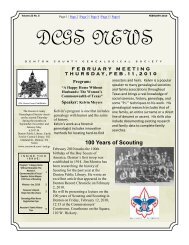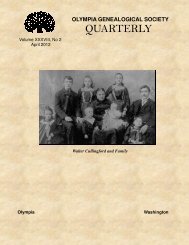Getting to the Roots of Your Family - RootsWeb - Ancestry.com
Getting to the Roots of Your Family - RootsWeb - Ancestry.com
Getting to the Roots of Your Family - RootsWeb - Ancestry.com
You also want an ePaper? Increase the reach of your titles
YUMPU automatically turns print PDFs into web optimized ePapers that Google loves.
ascertain <strong>the</strong> PLU. Use <strong>the</strong> FHL Catalog record for <strong>the</strong> <strong>to</strong>wnland in <strong>the</strong> 1911 census <strong>to</strong> find <strong>the</strong><br />
DED. Locate <strong>the</strong> 1911 census FHLC record by doing a ‘Keyword’ search for <strong>the</strong> <strong>to</strong>wnland.<br />
O<strong>the</strong>r Valuation Records<br />
• There were several surveys taken under <strong>the</strong> direction <strong>of</strong> Richard Griffith in preparation for <strong>the</strong><br />
Primary Valuation. Among <strong>the</strong>se are Field Books, Tenure Books, House Books and Quar<strong>to</strong> Books.<br />
• Find in <strong>the</strong> FHLC using a keyword search with <strong>the</strong> words Ireland Tenure Quar<strong>to</strong>. They may also<br />
be found in <strong>the</strong> FHLC under Ireland and <strong>the</strong>n <strong>the</strong> <strong>to</strong>pic “Land and Property,” <strong>the</strong>n look for <strong>the</strong> title<br />
“Valuation Books” with <strong>the</strong> author “Ireland. General Valuation Office.”<br />
• The FHL has filmed <strong>the</strong> House books, Field books, Tenure books, and Quar<strong>to</strong> books. Although it<br />
was filmed at <strong>the</strong> National Archives in Dublin, it does contain much material for Nor<strong>the</strong>rn Ireland.<br />
House Books<br />
• There was a stipulation that a house only be valued if it was worth £3 and later £5. However in<br />
many counties <strong>the</strong>y valued homes that were way under that limit. The names <strong>of</strong> <strong>the</strong> occupiers <strong>of</strong><br />
each house are listed. However, in a parish in Donegal, only two people listed, <strong>the</strong> richest two people<br />
in <strong>the</strong> parish, no doubt, <strong>the</strong> landlord and <strong>the</strong> Anglican minister.<br />
• These books cover <strong>the</strong> late 1820s <strong>to</strong> <strong>the</strong> early 1850s.<br />
• According <strong>to</strong> Reilly (see below) Quar<strong>to</strong> books are for House books for large <strong>to</strong>wns.<br />
• The house books describe <strong>the</strong> size and quality <strong>of</strong> <strong>the</strong> house. Here is what <strong>the</strong> letters meant (from<br />
Reilly, p. 18, see below):<br />
New or Nearly New<br />
A+ Built or ornamented with cut s<strong>to</strong>ne, and <strong>of</strong> superior solidity, and finish.<br />
A Very substantial building, and finish, without cut s<strong>to</strong>ne ornament<br />
A- Ordinary building and finish or ei<strong>the</strong>r <strong>of</strong> <strong>the</strong> above when built 20 or 25 years.<br />
Medium<br />
B+ Medium (not new) but in sound order, and good repair<br />
B Medium, slightly decayed, but in good repair<br />
B- medium, deteriorated by age, and not in perfect repair<br />
Old<br />
C+ Old, but in repair<br />
C Old and out <strong>of</strong> repair<br />
C- Old, and dilapidated, scarcely habitable<br />
Each letter was fur<strong>the</strong>r qualified with <strong>the</strong> number 1, 2 or 3:<br />
1 Slated ro<strong>of</strong> house <strong>of</strong> s<strong>to</strong>ne or brick with lime mortar<br />
2 Thatched ro<strong>of</strong> house <strong>of</strong> s<strong>to</strong>ne or brick with lime mortar<br />
3 Thatched house <strong>of</strong> s<strong>to</strong>ne walls with mud mortar or mud walls <strong>of</strong> <strong>the</strong> best kind<br />
4 Basement s<strong>to</strong>ries <strong>of</strong> slated houses used as dwellings<br />
Field Books<br />
• The field books were created by <strong>the</strong> valua<strong>to</strong>rs looking at <strong>the</strong> soil in every parish in all <strong>of</strong> Ireland. A<br />
description <strong>of</strong> <strong>the</strong> soils and its worth is given.<br />
• The content varies. In some areas, <strong>the</strong> valua<strong>to</strong>rs added <strong>the</strong> names <strong>of</strong> <strong>the</strong> occupiers <strong>to</strong> <strong>the</strong> field books.<br />
David Ouimette states that <strong>the</strong> Field books for counties Cork, Dublin, Kerry and Limerick give<br />
occupiers’ names for all parishes, and <strong>the</strong> books for Carlow, Westmeath, Wexford, and Wicklow<br />
give occupiers names for most parishes. O<strong>the</strong>r counties only give occupiers names for a few<br />
parishes.<br />
Tenure Books<br />
• Tenure books describe <strong>the</strong> type <strong>of</strong> lease each tenement was held under. Includes names <strong>of</strong> all <strong>of</strong> <strong>the</strong><br />
tenement holders.



